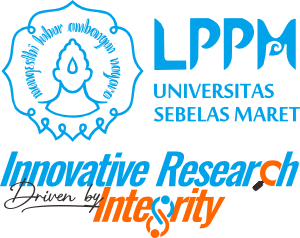Keywords: PUFA, production performance, carcass performance, chemical quality of meat, physical quality of meat, cholesterol meat, meat PUFA
By: Ir. Joko Riyanto, MP., Ir. Susi Dwi Widyawati, MS., Wara Pratitis, SPt, MP
This study aims to make the formulation of feed for fattening cattle in the form of concentrates rich of PUFA (poly unsaturated fatty acid) local feed ingredients in Feedlot beef cattle fattening SimPO based on rice straw fermented basal diet, the evaluation results of carcass and its components, physical and chemical quality of meat is mainly an evaluation of meat cholesterol and PUFA content . Rations are given in the form of fermented rice straw (30%) and concentrate-PUFA (70%). Implementation of biological test research in the Animal Husbandry Department of. Agriculture Faculty UNS, analysis of cholesterol in the Lab. Biochemistry and Nutrition Faculty of Animal Husbandry UGM, and the levels of PUFA in the Lab. Biochemistry PAU UGM in 2010. Treatments consisted of P0 (30% concentrate basal: 70% of fermented rice straw), P1 (P0 +5% palm oil supplementation), P2 (P0 +5% lemuru fish oil supplementation), P3 (P0 +10% fish meal supplementation) , and P4 (P0 +10% soy groats supplementation). Oil palm and lemuru protected by saponification for fish meal and soybean groats protected 5% formaldehyde. The design used completely randomized design using as many as 15 head of cattle SimPO, each treatment was repeated 3 times.
Done biological test all cattle slaughtered and prepared meat carcasses and samples taken on Longissimus dorsi muscle (meat Sirloin) to known physical and chemical meat quality. The results PUFA supplementation sources (palm oil, lemuru fish oil, fish meal and soybean groats) gave highly significant effect on weight gain (P ≤ 0.01), ADG (P ≤ 0.05), carcass weight (P ≤ 0 , 05), slaughter weight and meat weight (P ≤ 0.01), meat cholesterol content (P ≤ 0.05), content of oleic acid, and linolenic acid linoeat (P ≤ 0.05) and no influence on the physical quality of meat (P≥0.05). Cholesterol content of beef fed the basal concentrate with PUFA supplementation lower cholesterol (P ≤ 0.05) compared with beef cattle that were given only the basal concentrate. Lemuru fish oil
supplementation produce beef with high levels of oleic fatty acid, linoleic and linolenic acid supplementation higher than palm oil, fish meal, soybean groats and concentrates.
Conclusion cows fed various sources of PUFA supplementation gave the same response to weight gain and ADG. Carcass weight and meat weight with supplementation of palm oil and soya groats both higher than that disupelementasi lemuru fish oil and fish meal. Cholesterol content of beef supplemented fish meal 20.54 mg/100ml and groats soybean 19.15 mg/100ml lower than in lemuru fish oil supplementation 26.90 mg/100 ml andpalm oil 29.08 mg/100ml and concentrate basal 40, 41 mg/100 ml. Lemuru fish oil supplementation produce beef with high levels of oleic fatty acid 832.24 mg/100 ml, linoleic 101.91 mg/100 ml and linolenic 7.77 mg/100 ml higher than the other treatments supplementation. PUFA supplementation differences give the same response to the physical quality of meat.

